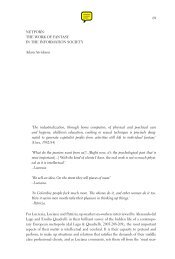Nakamura, Digitizing Race, Introduction, chapter 5, Epilogue
Nakamura, Digitizing Race, Introduction, chapter 5, Epilogue
Nakamura, Digitizing Race, Introduction, chapter 5, Epilogue
You also want an ePaper? Increase the reach of your titles
YUMPU automatically turns print PDFs into web optimized ePapers that Google loves.
8 <strong>Introduction</strong><br />
as “disembodiment” and “cybertheory.” This was a significant departure from<br />
art history as a critical practice before this time, which had been, as Apter<br />
says, concerned with things like “provenance, appraisal, appropriation, [and]<br />
authentication.” This initial disavowal of the digital by art history is one of<br />
the raisons d’être for visual culture; in 1996, scholars trained in visual analysis<br />
as art historians conceded that the digital is far too important to be ignored,<br />
yet many concluded that its particular histories, intertextualities, modes of<br />
materiality and production, technology, and ephemerality either do not exist<br />
or do so in such a way that they exceed the range of critique of traditional<br />
art history or criticism.<br />
However, as it turns out, many other scholars trained in art history spoke<br />
strongly for the relevance and influence of the digital on the field of visual<br />
analysis. David Rodowick, a more sanguine contributor to the October questionnaire,<br />
asserts that the effect of the digital has been to create an “audiovisual<br />
culture” in which objects no longer have a material existence as traditionally<br />
conceived: “The new media inspire visual studies through an implicit<br />
philosophical confrontation. Cinema and the electronic arts are the products<br />
of concepts that cannot be recognized by the system of aesthetics, nor<br />
should they be.” Thus Rodowick posits a shift in the nature of representation<br />
itself, begun by cinema and hastened by new media, which renders<br />
many of Armstrong’s concerns with materiality, history, and production<br />
either irrelevant or radically shifted in orientation. Rodowick, along with<br />
Nicholas Mirzoeff, Coco Fusco, Lisa Cartright, Marita Sturken, and Stuart<br />
Hall, helped to initiate the field of visual culture studies in the academy<br />
through their advocacy, which was multidisciplinary in nature (Mirzoeff is<br />
an art historian; Sturken and Cartright are media scholars; Fusco is a performance<br />
artist, public intellectual, and gender and postcolonial theorist;<br />
and Hall is best known as a cultural studies scholar). They have been very<br />
successful in this task in a relatively short time, so much so that in 2004<br />
Jonathan Sterne could challenge the perceived hegemony of visual culture<br />
approaches to new media by asking “Is Digital Culture Visual Culture?” 11<br />
Since 1996, the date of the questionnaire, visual culture has become a field<br />
that has won some disciplinary recognition: it has a well-respected journal,<br />
the Journal of Visual Culture, which publishes contributions from a wide<br />
range of scholars and departments, and schools or programs at several major<br />
universities. An examination of the early debates in October that initiated<br />
the use of visual culture studies in the academy shows us that despite its origins<br />
in art history and criticism, visual culture has always been preoccupied<br />
with the digital. Lisa Cartright writes that media convergence, an effect of





